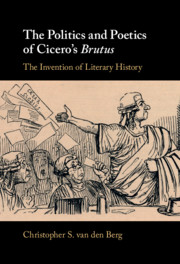Book contents
- The Politics and Poetics of Cicero’s Brutus
- The Politics and Poetics of Cicero’s Brutus
- Copyright page
- Dedication
- Contents
- Preface and Acknowledgments
- A Note on the Text
- Abbreviations
- Introduction
- Chapter 1 Ciceropaideia
- Chapter 2 The Intellectual Genealogy of the Brutus
- Chapter 3 Caesar and the Political Crisis
- Chapter 4 Truthmaking and the Past
- Chapter 5 Beginning (and) Literary History
- Chapter 6 Perfecting Literary History
- Chapter 7 Cicero’s Attici
- Chapter 8 Minerva, Venus, and Cicero’s Judgments on Caesar’s Style
- Conclusion
- References
- General Index
- Index Locorum
Chapter 4 - Truthmaking and the Past
- The Politics and Poetics of Cicero’s Brutus
- The Politics and Poetics of Cicero’s Brutus
- Copyright page
- Dedication
- Contents
- Preface and Acknowledgments
- A Note on the Text
- Abbreviations
- Introduction
- Chapter 1 Ciceropaideia
- Chapter 2 The Intellectual Genealogy of the Brutus
- Chapter 3 Caesar and the Political Crisis
- Chapter 4 Truthmaking and the Past
- Chapter 5 Beginning (and) Literary History
- Chapter 6 Perfecting Literary History
- Chapter 7 Cicero’s Attici
- Chapter 8 Minerva, Venus, and Cicero’s Judgments on Caesar’s Style
- Conclusion
- References
- General Index
- Index Locorum
Summary
Chapter 4 turns to the pedagogical workings of the Brutus: it instills in the reader a new sense of how to organize and assess the literary past. Syncrisis is central to conceptualizing the past and to portraying individuals and groups across cultures and generations. The dialogue also spends a considerable amount of time reflecting on historical accuracy, for example in the discussions of Coriolanus and Themistocles (41–44), the laudatio funebris (62), the beginning of Latin literature with Livius Andronicus (72–73), and Curio’s dialogue about Caesar’s consulship (218–19). Taken together these reflections on rhetorical presentation of the past help us to understand the freedom with which Cicero handles the data of his literary history. Several claims, exaggerations, and fabrications can be explained by Cicero’s desire to craft meaningful parallels in his history of Latin oratory and literature, including his insistence on Naevius’ death in 204 BCE (60). Such parallels reveal in turn the close interconnection of his intellectual and ideological commitments.
Keywords
- Type
- Chapter
- Information
- The Politics and Poetics of Cicero's BrutusThe Invention of Literary History, pp. 102 - 134Publisher: Cambridge University PressPrint publication year: 2021



